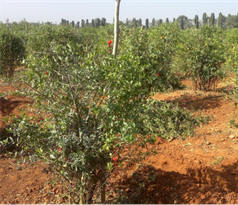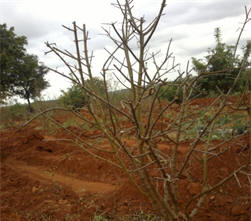|
Flowering
In tropical South and central
Indian condition, there are three flowering seasons,
viz., January-February (ambia bahar) ; June- July
(mrig bahar) and September-October (hasta
bahar). The choice of flowering/fruiting depends on
availability of irrigation water, market demand and
incidence of pest and diseases.
This is again the choice of the
grower regarding which of the 3 bahars to
consider taking into account the non availability of
water during April–May, forced for rest in April–May is
possible, Fruit cracking in June- July due to rain,
farmers prefer mrig bahar, Bacterial nodal blight
during rainy season and rainy, winter season crops -
heavy than spring crop.
Process of bahar
treatment
• Withhold the irrigation two months prior to the bahar
• In light sandy and shallow soils, withhold water for
4–5weeks
• Due to water stress, leaves show wilting and fall on
the ground
• The trees are medium pruned 40-45 days after
withholding irrigation.
• Give ethrel spray at 2 to 2.5 ml/l mixed with 5 g/l of
DAP
• At this stage cover the roots with a mixture of soil
and FYM and irrigate immediately.
• Apply the recommended doses of fertilizers immediately
after pruning
• Consequently, new growth, profuse flowering and
fruiting is observed
• Resume the normal irrigation.
• The fruits are ready for harvest 5 months after
flowering.
Crop
and grade regulation
A grown-up, well-managed tree at
three years age gives 80–100 fruits annually, and
increases by ten percent annually of which
·
8–10 % are of ‘A’ grade
·
20–25% of ‘B’ grade,
·
Remaining ‘C’ and ‘D’ grades, and cracked fruits.
Improve average grade by crop regulation.
•
After the fruit set, do not allow fruits to develop in
clusters and keep only solitary fruits.
• Allow flower set on inner/thicker shoots to develop in
to fruits, remove those which are developed terminally
on weaker shoots
• After getting set, remove all the flowers coming
thereafter.
Operation to be done during pre pruning and
pruning
·
Spray 1% Bordeaux mixture 2 days before defoliation.
·
Prune the twigs carefully
·
Sterilize the secateurs with sodium hypochlorite
(2 to 3 ml/l)
·
Defoliate with a mixture of ethrel (2 to 2.5 ml/l) + DAP
5g/l.
·
Remove weeds and suckers
·
Collect & burn fallen leaves /debris from the orchard
·
Harrowing in interspaces is advocated.
·
Apply full dose of well rotten FYM and P, 1/3rd N&K
fertilizers + Micronutrients (ZnSO4, FeSO4,
MnSO4 each 25g and 10g Borax (Boron) /tree)+
Neem Cake 1-1.5 kg / tree + Vermicompost 2 kg/tree+
Phorate10G @25g/tree or Carbofuran 3G at 40g/tree in
shallow trench or ring (15-20 cm wide of 8-10cm
depth) at 45-60cm away from the stem, cover the trenches
properly with soil and give light irrigation immediately
after fertilizer application.
·
After 45 days
apply 1/3rd dose of Nitrogen + 1/3rd dose of
potash
·
After 90 days apply 1/3rd dose of Nitrogen + 1/3rd dose
of potash

Pruned palnt before leaf fall |
|

Pruned palnt after leaf fall
|

Remove the pruned wood from the field |
|

Retain flowers originating on stronger
shoots |
The females can be identified by
the miniature fruit / bulged structure at the flower
base which is the swollen ovary at the base of the
bloom. Normally, the male flowers show up first,
followed by the females in about 7 to 10 days. The ratio
on plants is about 10 to 1 male to female.
|